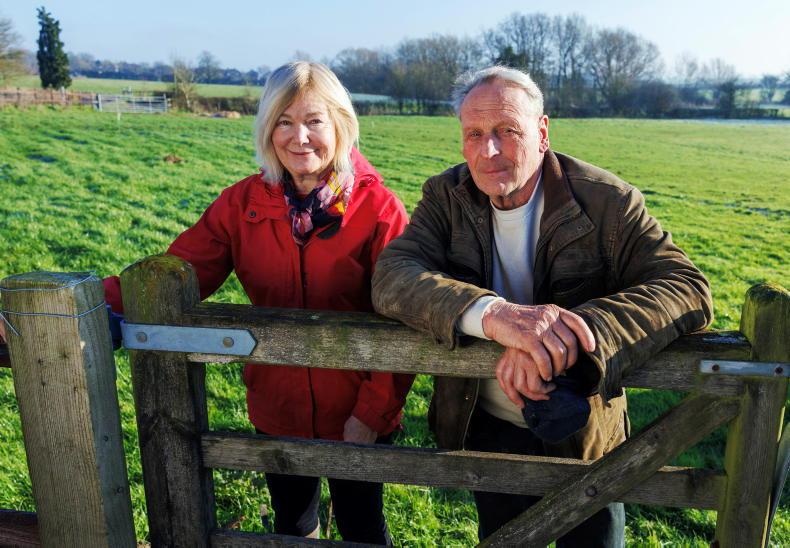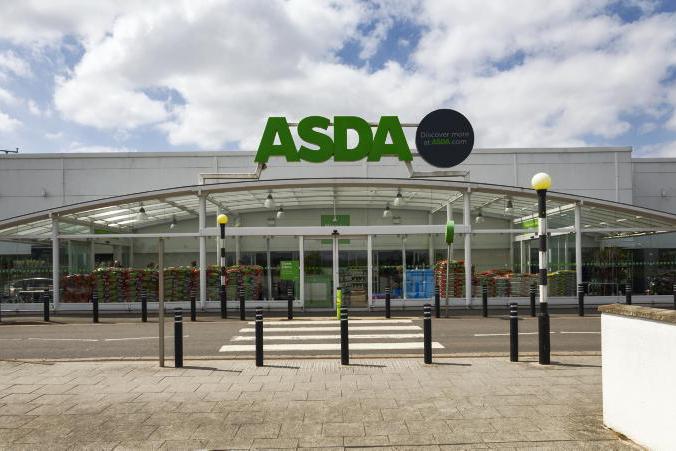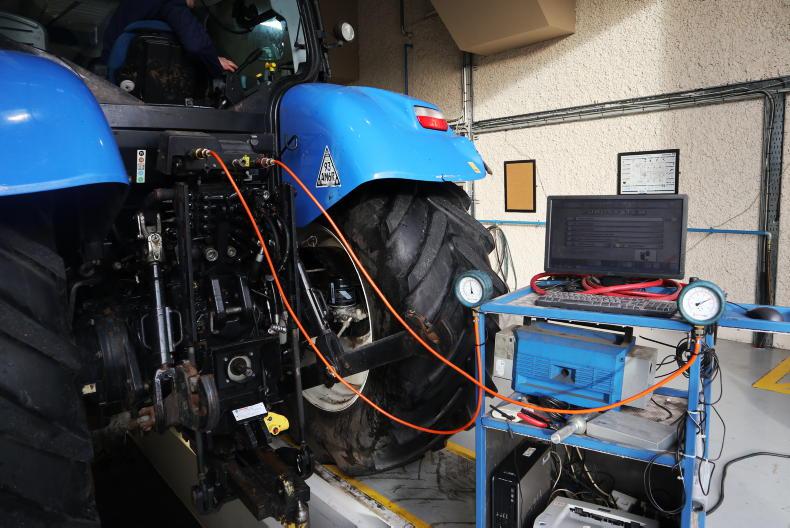Leyland enthusiast Mark Johnson, purchased his six-cylinder Leyland 285 Synchro in 1991.
Manufactured in November 1979, its VIN number 248386 identifies the tractor as being a late-production Synchro model, and one of the last 285s to be built.
It’s a tractor Johnson cherishes, yet its historical legacy is a story which is inherently flawed.
The six-cylinder Leyland tractor was developed in response to a demand for greater power from export markets like Australia.

Mark Johnson.
Leyland engineers had reportedly considered (and would later adopt), turbocharging a four-cylinder engine as a means of producing greater horsepower.
However, with a new six-cylinder engine at their disposal, for Leyland engineers in 1972 it was a no-brainer.
At the time of their launch in November 1972, the two-wheel-drive Leyland 285 (85hp) and the 2100 (100hp) were among the very first OEM-production six-cylinder tractors manufactured in the UK.
Built at Bathgate in Scotland, they were launched alongside the Leyland 485 (85hp) and 4100 (100hp) four-wheel-drive models.

The Leyland 285 was the first tractor in the company’s manufacturing history to feature oil-immersed disc brakes and epicyclic final drives.
The four-wheel-drive tractors, were built using driveline components developed and manufactured for Leyland Tractors by County Commercial Cars Ltd.
County also supplied the oil-immersed braking system and epicyclic final drives used on the two-wheel-drive models.
The four-wheel-drive system used on the 485/4100 models, employed the same twin telescopic driveshaft arrangement County used on its own tractors, taking drive from either side of the rear diff to hubs driving equal-sized front wheels.
Power for all four six-cylinder models was provided by a naturally aspirated 5.8 litre six-cylinder Leyland 6/98N engine.
The tractors also shared a Leyland/Nuffield 10F/4R transmission, a two-speed independent PTO and a rated linkage lift capacity of 2,720kg.

Leyland introduced a Q-cab to its tractor lineup in 1976. The six-cylinder two-wheel drive models famously featured an exhaust system which exited behind the cab.
Inside the cab, the six-cylinder tractors were equipped with side-mounted gear levers, and came with power-assisted steering as standard. But there were some problems.
Strain
It was soon discovered the engine side frames were inadequate for the power of the engine, causing them to continually flex under load.
This placed a great deal of strain on the tractor’s rubber engine mounts, which would eventually fail, resulting in the engine torquing itself out of alignment with the clutch and drivetrain, with catastrophic consequences.

The Leyland 285 Synchro cab interior was purely functional with cladding applied to the roof, fenders and floor mat to suppress noise levels. Note the gear lever to the side of the seat.
As a result of this design flaw, County would not warranty its components on the 485 /4100 models, which in hindsight is perhaps why only a handful were produced.
Between 1975 and the cessation of four-wheel-drive production in 1977, just nine 4100 tractors and two 485 tractors were sold in the UK, with five and three respectively finding homes on the export market.
Another problem which plagued the six-cylinder models, was the 10-speed gearbox.
This was essentially the same ‘five-two’ gearbox used in the four-cylinder Nuffield/Leyland tractors, albeit with some minor upgrades, and early models in particular were beset by transmission problems.
Production developments of the six-cylinder models, included a minor facelift and the introduction of quiet-cab in 1976. In 1978, Leyland introduced the Synchro gearbox.

The Leyland 485 and slightly more powerful 4100 featured an equal-wheel four-wheel drive system developed by County Commercial Cars. This is an early-production 1972 Leyland 485.
This was a new full-synchromesh 9F/3R transmission design, which would represent the last major mechanical tractor development implemented by Leyland.
Both the 285 and the 2100 would benefit from the new Synchro transmission, however the combination of a poor reputation and competition from manufacturers including Ford, International Harvester and a newcomer to Europe called John Deere, kept sales figures to a minimum.
When Johnson purchased his tractor, its post-production 1982 registration (KEC 64X) was something of a mystery.
The tractor was originally supplied by Lancashire dealer Bryan Hoggarth Tractors. Fortunately, while many of the records at the dealership were destroyed in a fire, Johnson has since uncovered some of the history behind his tractor.
Leyland offered the tractors to some of its UK dealers, and Mr Hoggarth bought five of them
“In 1981, Bryan Hoggarth discovered that there were six brand-new Leyland 285 Synchro tractors left in Italy, which had not been sold,” reveals Johnson.
“Leyland offered the tractors to some of its UK dealers, and Mr Hoggarth bought five of them. The sixth one was sold to Fred Fletcher Tractors at Colne.
“As the story goes, Mr Hoggarth soon sold four of the tractors, but there were two farmers who were keen to buy the last one.
“Apparently he called Fred Fletcher, who let him have the sixth tractor, which was sold to J Graves & Son at Silverdale in Lancashire.”
Last Leyland
The Leyland 285 Synchro sold to Graves was the last brand-new Leyland 285 Synchro sold in Britain. This is the tractor Mark Johnson owns today, and he still uses it on his Staffordshire farm for mowing, muck-spreading and hedge-cutting. Production of the blue-painted Leyland Synchro models ceased in December 1979.
In December 1980 Leyland launched the Golden Harvest range of tractors. Subtly re-styled with a golden livery, they debuted the optional Sekura Explorer Q-cab.
Sadly, the six-cylinder models didn’t survive the Harvest Gold revamp, and the new range was topped by the four-cylinder turbocharged 802 and 804 models.
The six-cylinder Leyland models should have been a major success
This makes the two-wheel-drive Leyland 285s a rare sight these days, although they’re not as scarce as their four-wheel-drive equivalents.
The six-cylinder Leyland models should have been a major success, but like so many other Leyland vehicles at the time, they were underdeveloped and never lived up to expectations.
Subsequently many have now vanished into obscurity. However, if you do still own one, you might want to take a leaf out of Mark Johnson’s book and hang on to it.
Leyland enthusiast Mark Johnson, purchased his six-cylinder Leyland 285 Synchro in 1991.
Manufactured in November 1979, its VIN number 248386 identifies the tractor as being a late-production Synchro model, and one of the last 285s to be built.
It’s a tractor Johnson cherishes, yet its historical legacy is a story which is inherently flawed.
The six-cylinder Leyland tractor was developed in response to a demand for greater power from export markets like Australia.

Mark Johnson.
Leyland engineers had reportedly considered (and would later adopt), turbocharging a four-cylinder engine as a means of producing greater horsepower.
However, with a new six-cylinder engine at their disposal, for Leyland engineers in 1972 it was a no-brainer.
At the time of their launch in November 1972, the two-wheel-drive Leyland 285 (85hp) and the 2100 (100hp) were among the very first OEM-production six-cylinder tractors manufactured in the UK.
Built at Bathgate in Scotland, they were launched alongside the Leyland 485 (85hp) and 4100 (100hp) four-wheel-drive models.

The Leyland 285 was the first tractor in the company’s manufacturing history to feature oil-immersed disc brakes and epicyclic final drives.
The four-wheel-drive tractors, were built using driveline components developed and manufactured for Leyland Tractors by County Commercial Cars Ltd.
County also supplied the oil-immersed braking system and epicyclic final drives used on the two-wheel-drive models.
The four-wheel-drive system used on the 485/4100 models, employed the same twin telescopic driveshaft arrangement County used on its own tractors, taking drive from either side of the rear diff to hubs driving equal-sized front wheels.
Power for all four six-cylinder models was provided by a naturally aspirated 5.8 litre six-cylinder Leyland 6/98N engine.
The tractors also shared a Leyland/Nuffield 10F/4R transmission, a two-speed independent PTO and a rated linkage lift capacity of 2,720kg.

Leyland introduced a Q-cab to its tractor lineup in 1976. The six-cylinder two-wheel drive models famously featured an exhaust system which exited behind the cab.
Inside the cab, the six-cylinder tractors were equipped with side-mounted gear levers, and came with power-assisted steering as standard. But there were some problems.
Strain
It was soon discovered the engine side frames were inadequate for the power of the engine, causing them to continually flex under load.
This placed a great deal of strain on the tractor’s rubber engine mounts, which would eventually fail, resulting in the engine torquing itself out of alignment with the clutch and drivetrain, with catastrophic consequences.

The Leyland 285 Synchro cab interior was purely functional with cladding applied to the roof, fenders and floor mat to suppress noise levels. Note the gear lever to the side of the seat.
As a result of this design flaw, County would not warranty its components on the 485 /4100 models, which in hindsight is perhaps why only a handful were produced.
Between 1975 and the cessation of four-wheel-drive production in 1977, just nine 4100 tractors and two 485 tractors were sold in the UK, with five and three respectively finding homes on the export market.
Another problem which plagued the six-cylinder models, was the 10-speed gearbox.
This was essentially the same ‘five-two’ gearbox used in the four-cylinder Nuffield/Leyland tractors, albeit with some minor upgrades, and early models in particular were beset by transmission problems.
Production developments of the six-cylinder models, included a minor facelift and the introduction of quiet-cab in 1976. In 1978, Leyland introduced the Synchro gearbox.

The Leyland 485 and slightly more powerful 4100 featured an equal-wheel four-wheel drive system developed by County Commercial Cars. This is an early-production 1972 Leyland 485.
This was a new full-synchromesh 9F/3R transmission design, which would represent the last major mechanical tractor development implemented by Leyland.
Both the 285 and the 2100 would benefit from the new Synchro transmission, however the combination of a poor reputation and competition from manufacturers including Ford, International Harvester and a newcomer to Europe called John Deere, kept sales figures to a minimum.
When Johnson purchased his tractor, its post-production 1982 registration (KEC 64X) was something of a mystery.
The tractor was originally supplied by Lancashire dealer Bryan Hoggarth Tractors. Fortunately, while many of the records at the dealership were destroyed in a fire, Johnson has since uncovered some of the history behind his tractor.
Leyland offered the tractors to some of its UK dealers, and Mr Hoggarth bought five of them
“In 1981, Bryan Hoggarth discovered that there were six brand-new Leyland 285 Synchro tractors left in Italy, which had not been sold,” reveals Johnson.
“Leyland offered the tractors to some of its UK dealers, and Mr Hoggarth bought five of them. The sixth one was sold to Fred Fletcher Tractors at Colne.
“As the story goes, Mr Hoggarth soon sold four of the tractors, but there were two farmers who were keen to buy the last one.
“Apparently he called Fred Fletcher, who let him have the sixth tractor, which was sold to J Graves & Son at Silverdale in Lancashire.”
Last Leyland
The Leyland 285 Synchro sold to Graves was the last brand-new Leyland 285 Synchro sold in Britain. This is the tractor Mark Johnson owns today, and he still uses it on his Staffordshire farm for mowing, muck-spreading and hedge-cutting. Production of the blue-painted Leyland Synchro models ceased in December 1979.
In December 1980 Leyland launched the Golden Harvest range of tractors. Subtly re-styled with a golden livery, they debuted the optional Sekura Explorer Q-cab.
Sadly, the six-cylinder models didn’t survive the Harvest Gold revamp, and the new range was topped by the four-cylinder turbocharged 802 and 804 models.
The six-cylinder Leyland models should have been a major success
This makes the two-wheel-drive Leyland 285s a rare sight these days, although they’re not as scarce as their four-wheel-drive equivalents.
The six-cylinder Leyland models should have been a major success, but like so many other Leyland vehicles at the time, they were underdeveloped and never lived up to expectations.
Subsequently many have now vanished into obscurity. However, if you do still own one, you might want to take a leaf out of Mark Johnson’s book and hang on to it.















SHARING OPTIONS